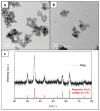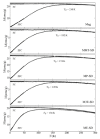Synthesis and Characterization of Magnetic Composite Theragnostics by Nano Spray Drying
- PMID: 35268986
- PMCID: PMC8911310
- DOI: 10.3390/ma15051755
Synthesis and Characterization of Magnetic Composite Theragnostics by Nano Spray Drying
Abstract
Composites of magnetite nanoparticles encapsulated with polymers attract interest for many applications, especially as theragnostic agents for magnetic hyperthermia, drug delivery, and magnetic resonance imaging. In this work, magnetite nanoparticles were synthesized by coprecipitation and encapsulated with different polymers (Eudragit S100, Pluronic F68, Maltodextrin, and surfactants) by nano spray drying technique, which can produce powders of nanoparticles from solutions or suspensions. Transmission and scanning electron microscopy images showed that the bare magnetite nanoparticles have 10.5 nm, and after encapsulation, the particles have approximately 1 μm, with size and shape depending on the material's composition. The values of magnetic saturation by SQUID magnetometry and mass residues by thermogravimetric analysis were used to characterize the magnetic content in the materials, related to their magnetite/polymer ratios. Zero-field-cooling and field-cooling (ZFC/FC) measurements showed how blocking temperatures of the powders of the composites are lower than that of bare magnetite, possibly due to lower magnetic coupling, being an interesting system to study magnetic interactions of nanoparticles. Furthermore, studies of cytotoxic effect, hydrodynamic size, and heating capacity for hyperthermia (according to the application of an alternate magnetic field) show that these composites could be applied as a theragnostic material for a non-invasive administration such as nasal.
Keywords: composites; magnetic hyperthermia; magnetic nanoparticles; nano spray drying; superparamagnetism; theragnostic.
Conflict of interest statement
The authors declare no conflict of interest.
Figures








Similar articles
-
Nano Spray-Dried Drugs for Oral Administration: A Review.Assay Drug Dev Technol. 2021 Oct;19(7):412-441. doi: 10.1089/adt.2021.053. Epub 2021 Sep 21. Assay Drug Dev Technol. 2021. PMID: 34550790 Review.
-
Formulation and characterization of inhalable magnetic nanocomposite microparticles (MnMs) for targeted pulmonary delivery via spray drying.Int J Pharm. 2015 Feb 20;479(2):320-8. doi: 10.1016/j.ijpharm.2014.12.050. Epub 2014 Dec 24. Int J Pharm. 2015. PMID: 25542988 Free PMC article.
-
Presence of electrostatically adsorbed polysaccharides improves spray drying of liposomes.J Food Sci. 2013 Feb;78(2):E206-21. doi: 10.1111/1750-3841.12023. Epub 2013 Jan 16. J Food Sci. 2013. PMID: 23324113
-
Synthesis of magnetite/amphiphilic polymer composite nanoparticles as potential theragnostic agents.J Nanosci Nanotechnol. 2012 Jul;12(7):5920-4. doi: 10.1166/jnn.2012.6383. J Nanosci Nanotechnol. 2012. PMID: 22966681
-
Nano spray drying for encapsulation of pharmaceuticals.Int J Pharm. 2018 Jul 30;546(1-2):194-214. doi: 10.1016/j.ijpharm.2018.05.037. Epub 2018 May 17. Int J Pharm. 2018. PMID: 29778825 Review.
Cited by
-
Fortification of Iron Oxide as Sustainable Nanoparticles: An Amalgamation with Magnetic/Photo Responsive Cancer Therapies.Int J Nanomedicine. 2023 Oct 4;18:5607-5623. doi: 10.2147/IJN.S404394. eCollection 2023. Int J Nanomedicine. 2023. PMID: 37814664 Free PMC article. Review.
-
Recent Advances in Functionalized Nanoparticles in Cancer Theranostics.Nanomaterials (Basel). 2022 Aug 17;12(16):2826. doi: 10.3390/nano12162826. Nanomaterials (Basel). 2022. PMID: 36014691 Free PMC article. Review.
-
Electrospun Magnetic Nanofiber Mats for Magnetic Hyperthermia in Cancer Treatment Applications-Technology, Mechanism, and Materials.Polymers (Basel). 2023 Apr 15;15(8):1902. doi: 10.3390/polym15081902. Polymers (Basel). 2023. PMID: 37112049 Free PMC article. Review.
References
-
- Al-Jamal K., Bai J., Wang J., Protti A., Southern P., Bogart L., Heidari H., Li X., Cakebread A., Asker D., et al. Magnetic Drug Targeting: Preclinical in Vivo Studies, Mathematical Modeling, and Extrapolation to Humans. Nano Lett. 2016;16:5652–5660. doi: 10.1021/acs.nanolett.6b02261. - DOI - PubMed
LinkOut - more resources
Full Text Sources

